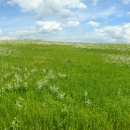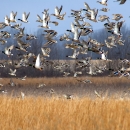What We Do
Wildlife conservation is at the heart of the National Wildlife Refuge System. It drives the management of all the lands and waters that are part of it, from the purposes for which a refuge is established, to the recreational activities offered, to the resource management tools used. Using conservation best practices, U.S. Fish and Wildlife Service employees manage Refuge System lands and waters to help ensure the survival of native species.
On Service-owned properties across the District, management is focused on wetland habitat preservation and improvement, waterfowl production, maintaining habitat for migratory birds, and providing winter habitat for resident wildlife.
The District also protects small wetlands and native grasslands by purchasing conservation easements from private landowners. District staff work with private landowners to assist with developing and restoring wildlife habitat. As part of this type of work, technical and cost-share assistance for agricultural and wildlife projects such as grazing systems, wetland restoration and creation, no-till planting, and grass seeding is available to private landowners.
Management and Conservation
Refuges use a host of scientifically sound management tools to address conservation challenges. These tools are all aimed at ensuring a balanced conservation approach to benefit both wildlife and people.
North Dakota has over 285,000 acres of habitat conserved as waterfowl production areas. These wetland and grassland habitats are managed through livestock grazing, haying, and prescribed burning. These tools improve and maintain grasslands for waterfowl and other nesting birds, helping to sustain North America's waterfowl populations.
Prescribed burning and grazing are preferred tools for enhancing native grasses. When timed properly, both of these techniques can improve vigor and change the species composition of native grasses. Haying and raking can also improve the native and tame grasses. Haying and grazing activities are accomplished by private landowners who have special use permits.
On occasion, private landowners enter into cooperative farming agreements with the U.S. Fish and Wildlife Service. Under these agreements, old stands of planted grasslands are broken out and farmed for successive years and then seeded back to tame or native grass species.
Invasive weed management techniques include chemical application, mowing, sheep grazing, and biological controls such as flea beetles on leafy spurge.
Our Services
Cooperative Agriculture, Haying, and Grazing
To better accomplish our grassland management objectives, we regularly utilize agricultural practices to manage and enhance habitat for wildlife. If you are interested in grazing livestock, harvesting hay, or cooperatively farming on Tewaukon Wetland Management District lands, please contact Refuge Manager Patrick Fitzmorris at (701) 724-3598 ext. 2 or by email at patrick_fitzmorris@fws.gov
Visitor Services
The District headquarters shares an office with Tewaukon National Wildlife Refuge. Stop by our visitor center during normal business hours to learn more about our District, view the beautiful exhibits of native habitats and the wildlife that use them, visit our friendly staff, or use our indoor public restroom.
There are no visitor facilities located at individual waterfowl production areas.
Law Enforcement
U.S. Fish and Wildlife Service law enforcement officers have a wide variety of duties and responsibilities. Officers help visitors understand and obey wildlife protection laws. They work closely with state and local government offices to enforce Federal, State, and Refuge hunting regulations that protect migratory birds and other game species from illegal take and preserve legitimate hunting opportunities. Other law enforcement duties include patrolling closed areas or wilderness areas, maintaining good relationships with neighboring landowners, maintaining refuge boundaries, and participating in public events.
Laws and Regulations
Management actions on national wildlife refuges are bound by many mandates including laws and executive orders.


